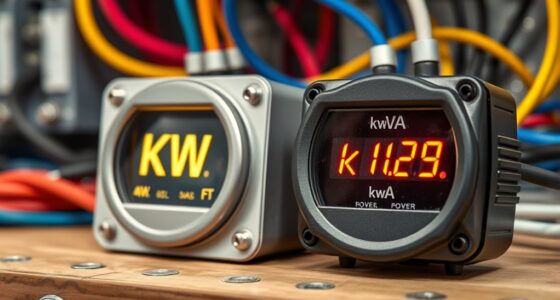To troubleshoot load shedding effectively, you need to master essential calculations like total load, current, voltage, and power factor. These help identify overloads, guarantee safety margins, and improve system stability. Calculating each factor accurately allows you to manage demand and prevent faults. If you want to keep your system running smoothly and avoid unexpected outages, understanding these key figures is vital — stay with us to explore each step in detail.
Key Takeaways
- Accurate load calculations identify peak demand and prevent overloads during load shedding.
- Determine current and voltage levels to ensure electrical safety and proper system operation.
- Assess power factor to improve efficiency and reduce reactive power wastage.
- Include safety margins in capacity estimates to accommodate fluctuations and system variability.
- Troubleshoot by analyzing consumption patterns and demand-supply balance to maintain grid stability.
Understanding Power Load Calculations

Understanding how to calculate power load is essential for effectively managing load shedding. When you accurately determine the total power demand, you can improve energy efficiency and support renewable integration. Start by listing all appliances and devices, noting their wattage and usage time. Add these figures to find the total load your system handles. Knowing this helps you identify peak periods and adjust consumption accordingly, reducing strain on the grid. It also enables you to prioritize essential devices, ensuring critical systems stay operational. By understanding your power load, you contribute to a more stable energy system and promote sustainable practices like renewable energy use. Precise calculations empower you to make smarter decisions, minimizing disruptions during load shedding and optimizing your energy consumption. Understanding load management is vital for maintaining system stability and efficiency.
Calculating Current and Voltage in Load Shedding Scenarios

When load shedding occurs, accurately calculating current and voltage is crucial to maintaining electrical safety and system stability. You need to assess how changes in load affect power distribution to prevent overloads. Start by applying Ohm’s Law and the power formulas to estimate current flow and voltage levels across different parts of the system. Remember, circuit breaker ratings are designed to protect against excessive current; knowing these ratings helps you determine if reductions in load are sufficient. Adjusting load based on these calculations ensures circuits aren’t overloaded, reducing the risk of faults or outages. Properly calculating current and voltage helps you maintain reliable power distribution during load shedding, keeping your system safe and functioning efficiently. Additionally, understanding the role of transformers in voltage regulation can help optimize power flow and enhance system stability during load adjustments.
Determining Power Factor and Its Impact on Load Management

Calculating current and voltage during load shedding is only part of managing electrical systems effectively. You also need to determine the power factor to optimize load management. Power factor reflects how efficiently your system uses electricity, with a low factor indicating wasted reactive power. Improving it through power factor correction reduces losses and enhances system stability. Reactive power management becomes essential when dealing with varying loads, as it impacts voltage regulation and equipment lifespan. By monitoring and adjusting the power factor, you can avoid overloading circuits and prevent unnecessary energy consumption. Properly managing reactive power ensures smoother load shedding, minimizes penalties, and maintains system reliability. Fundamentally, understanding and controlling the power factor is indispensable for efficient, safe, and cost-effective load management. A good power factor can also contribute to better customer satisfaction and lower operational costs over time.
Estimating Load Capacity and Safety Margins

Estimating load capacity and safety margins is essential for preventing overloads and guaranteeing system reliability. You need to account for generator efficiency, as it affects how much backup power is available under load. By accurately calculating the maximum load your system can handle, you avoid pushing equipment beyond safe limits. Incorporate a safety margin—typically 10-20%—to accommodate unexpected fluctuations and ensure your generator operates within its ideal range. This buffer helps prevent overloads and extends equipment lifespan. Keep in mind that overestimating capacity can lead to system failures, while underestimating compromises backup power availability. Regularly review your load estimates and adjust safety margins based on real-world performance to maintain a resilient, efficient power system. Understanding bank SWIFT/BIC codes is also important when managing international equipment purchases or spare parts, ensuring secure and accurate transactions.
Troubleshooting Common Load Shedding Issues Through Calculations

Identifying and resolving load shedding issues often begins with precise calculations to pinpoint the root causes. By analyzing energy consumption patterns, you can determine if demand exceeds supply, threatening grid stability. Calculations help identify whether energy conservation measures are effective or if certain areas are overloading the system. For example, checking load balances across different zones reveals imbalances that may trigger unnecessary load shedding. Accurate data allows you to adjust load management strategies, ensuring essential services remain active while reducing strain on the grid. Troubleshooting with calculations also helps foresee potential failures, enabling proactive steps. Conducting quality control tests on raw materials and system components ensures the reliability of the entire setup. Ultimately, these efforts support grid stability, prevent outages, and promote efficient energy use, making your load shedding system more reliable and responsive.
Frequently Asked Questions
How Often Should Load Calculations Be Reviewed for Accuracy?
You should review load calculations at least quarterly to maintain accuracy. Regular load monitoring helps identify changes in consumption patterns, ensuring your system remains efficient. It’s vital to update calculations promptly if there are upgrades or modifications to your setup. Doing so supports safety protocols, preventing overloads or shortages. Consistent reviews help you stay ahead of potential issues, keeping your load management reliable and compliant with safety standards.
What Tools Are Best for Performing Load Shedding Calculations?
You’ll want reliable tools like digital multimeters and circuit analysis software for load shedding calculations. These tools help you monitor power factor and conduct precise circuit analysis, ensuring accurate load assessments. While manual calculations are essential, software offers quick, detailed insights, reducing errors and saving time. Combining these tools empowers you to make informed decisions, optimize load management, and prevent overloads effectively.
How Do Environmental Factors Influence Load Management Decisions?
Environmental factors profoundly influence your load management decisions. You need to take into account renewable integration, which can introduce variability into the grid, affecting stability. Weather patterns, temperature, and seasonal changes impact energy demand and renewable output, so you must adjust load shedding strategies accordingly. By factoring in these environmental influences, you enhance grid stability and ensure reliable power supply while optimizing renewable energy use.
Can Load Shedding Calculations Be Automated for Real-Time Adjustments?
Yes, load shedding calculations can be automated for real-time adjustments. With the automation potential of advanced software, you can utilize real-time monitoring systems to continuously track electricity demand and supply. This enables automatic recalculations and adjustments, minimizing manual intervention. By integrating sensors and data analytics, you guarantee more efficient load management, reduce outages, and respond swiftly to changing environmental conditions or demand fluctuations, improving overall grid stability.
What Are Common Mistakes to Avoid in Load Capacity Estimations?
You should avoid capacity errors and estimation pitfalls by double-checking your calculations and considering all load factors. Don’t underestimate peak demands or overlook equipment inefficiencies, as these can lead to inaccurate load capacity estimations. Also, avoid relying solely on historical data without accounting for future growth. Always validate your assumptions and incorporate safety margins to guarantee your load capacity estimations are reliable and prevent unexpected load shedding issues.
Conclusion
Mastering load shedding calculations empowers you to troubleshoot efficiently and guarantee safety. By understanding how to determine current, voltage, and power factor, you can prevent overloads and optimize your power management. Are you ready to confidently handle load shedding issues and keep your system running smoothly? Remember, precise calculations aren’t just numbers—they’re your best tools for effective troubleshooting and maintaining a reliable power supply.









